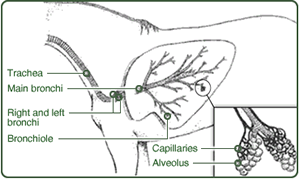|
|
Post by Admin on Dec 16, 2015 16:47:48 GMT -7
 The horse's respiratory system consists of the nostrils, pharynx, larynx, trachea, diaphragm, and lungs. Additionally, the nasolacrimal duct and sinuses are connected to the nasal passage. The horse's respiratory system not only allows the animal to breathe, but also is important in the horse's sense of smell (olfactory ability) as well as in communicating. The soft palate blocks off the pharynx from the mouth (oral cavity) of the horse, except when swallowing. This helps prevent the horse from inhaling food, but also means that a horse cannot use its mouth to breathe when in respiratory distress—a horse can only breathe through its nostrils. For this same reason, horses also cannot pant as a method of thermoregulation. The genus Equus also has a unique part of the respiratory system called the guttural pouch, which is thought to equalize air pressure on the tympanic membrane. Located between the mandibles but below the occiput, it fills with air when the horse swallows or exhales. Source: en.wikipedia.org/wiki/Equine_anatomy#Respiratory_system_and_smell |
|